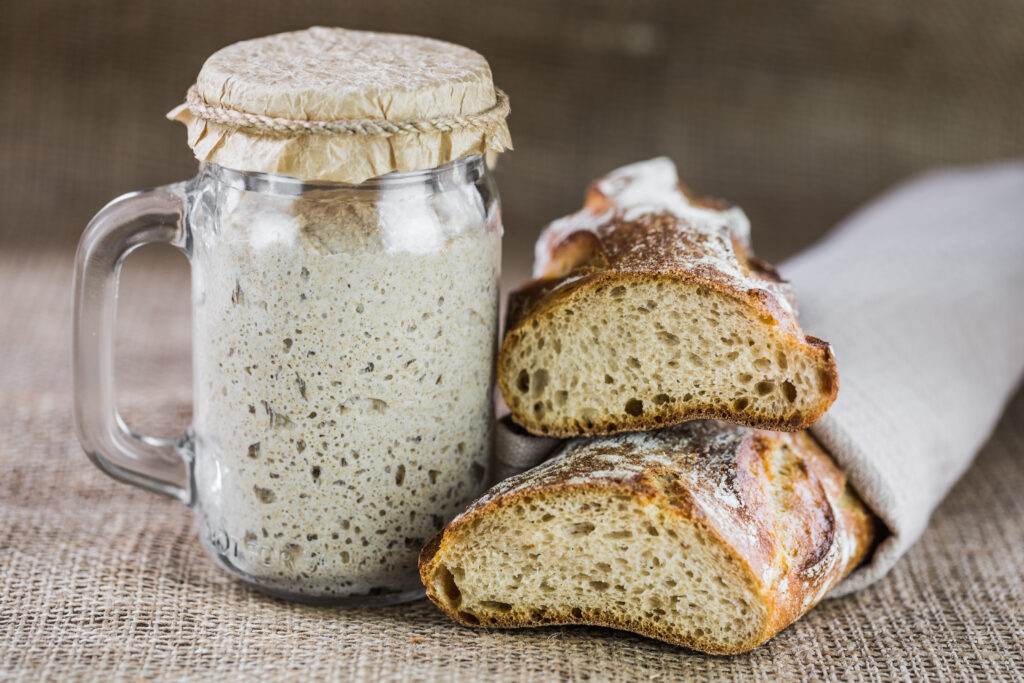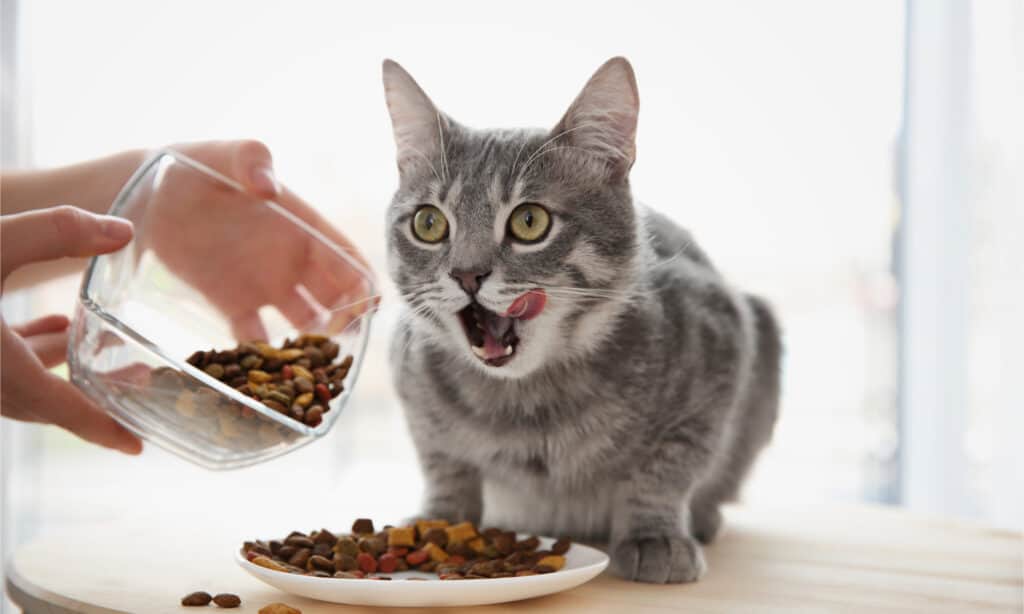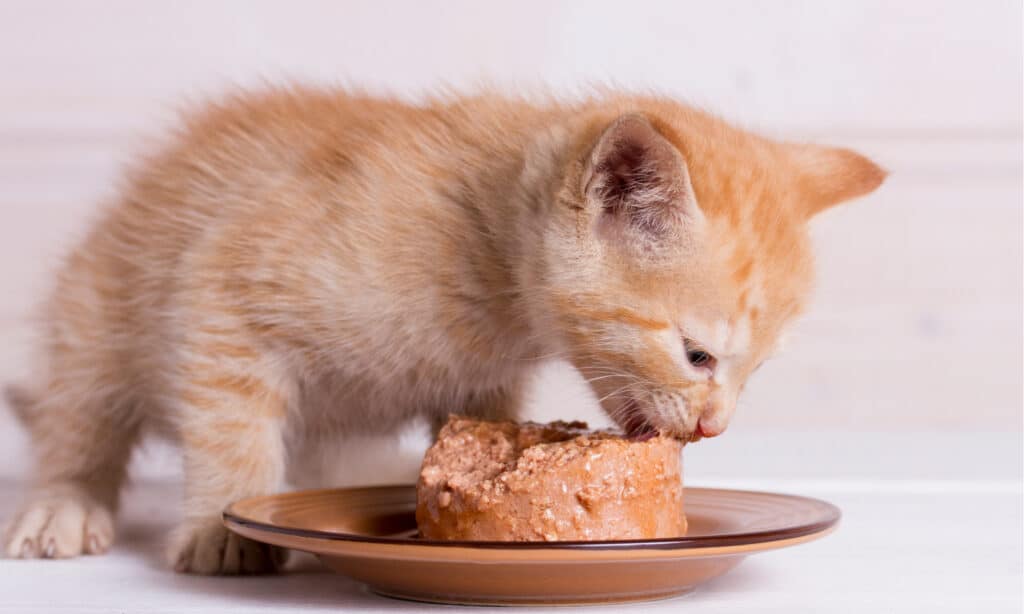It can be tempting to share whatever we’re eating with our cats, including our bread products. After all, if it’s good for us, it must be good for them, right? Unfortunately, this is often not true. When it comes to cats, there are a number of things that are either nonnutritious or downright harmful. So, can cats eat bread? Read on for the four things you should know before feeding your cat this yeasty food.
Can Cats Eat Bread?

Cats can safely eat plain baked bread in small quantities.
©Zagorulko Inka/Shutterstock.com
According to the ASPCA, cats can safely eat baked bread in small quantities. However, this comes with a huge caveat: cats should never eat unbaked, yeasted bread dough. Uncooked yeast ferments the carbohydrates in bread dough, releasing ethanol and carbon dioxide. Essentially, this can make your pet drunk and drastically bloat its stomach. This puts your cat at risk of various complications like bloating, ataxia (lack of coordination), disorientation, seizures, respiratory failure, and alcohol poisoning. Most of these can easily be fatal if left untreated.
In addition to uncooked bread dough, raisin bread is definitely a no-go for cats as raisins and grapes can cause kidney failure. In general, you should avoid giving your cat flavored bread in case it contains garlic, nuts, toxic fruits, or other off-limit foods.
4 Things to Know Before Feeding Your Cat Bread
Before feeding your cat bread, there are a few things you should know about its effects and how much to give.
1. Avoid Raw Bread Dough, Flavored Bread, and Spreads
It bears repeating that raw bread dough will cause untold problems for your cat, possibly even death. Additionally, avoid anything flavored, nutty, or baked with fruit pieces to prevent your cat from ingesting anything toxic. You should also avoid feeding your cat bread with spreads like butter or peanut butter, which are fattening, or anything with chocolate, which is toxic.
2. There Are No Real Benefits to Feeding Your Cat Bread

Bread lacks the nutrients cats need, which they get from meat or meat-based foods.
©Africa Studio/Shutterstock.com
Unlike many foods, there are no real benefits to adding bread to your cat’s diet. Worse, there are a number of drawbacks. These include the following:
- Calorie-rich. Bread tends to be rich in calories, most of which come from carbohydrates. Cats don’t need carbs in their diet, which makes these empty calories. This provides unnecessary filler for cats, in particular those that tend toward obesity or live a sedentary life. If your cat likes bread, give it to them in small, infrequent doses.
- May cause gastrointestinal issues. As with any new food, bread can cause trouble in a cat’s GI system if they aren’t used to it. This can result in a variety of symptoms including diarrhea, constipation, and vomiting. If your cat is asking for bread as a treat, give them a small piece first to see what the effects will be.
- Low nutritional value. Cats are obligate carnivores and thus need the kind of nutrients meat provides. Therefore, most of their calories should come from meat or meat-based foods. In particular, they need nutrients like protein, certain vitamins and minerals, fatty acids, and amino acids.
3. You Should Limit the Amount of Bread You Give Your Cat
Cats are obligate carnivores, which means they need meat in their diet to survive. They certainly don’t need bread, which is largely carbohydrates. For this reason, if you’re planning to give your cat bread, make sure to feed it to them in small quantities. It’s generally not appropriate as a daily treat.
If you’re wondering how much bread to give your cat, be aware that treats should make up no more than 10% of a cat’s daily caloric intake. Most cats require somewhere between 20 and 33 calories a day per healthy pound. Outdoor cats need more calories than indoor cats. This amounts to 200-330 calories a day for a 10-pound cat. (Keep in mind that you should always check with your vet for your cat’s specific caloric needs.) On average, one slice of plain white bread has about a fifth of your cat’s daily caloric needs. This is far too much to give your cat at one time. A small, bite-sized piece of bread is sufficient as an occasional treat. If in doubt, always check with your vet regarding new and human foods.
4. Your Cat May Not Like Bread
Even though baked bread is safe for cats in moderate amounts, it’s not necessarily their treat of choice. Most cats don’t gravitate toward bread given that it lacks the nutrients they need. If your cat isn’t actively asking for bread, it’s best not to introduce it to them. Try sticking to treats made specifically for cats. Here are lists of the best soft cat treats and best lickable cat treats for your beloved pet.
If your cat is a bread devotee, you may find it useful in getting them to take pills. Because bread is soft, it’s fairly easy to use it to hide pills from your cat.
What Food Should I Give My Cat?

Rather than giving your cat bread, go for food and treats specifically designed for cats.
©Elizabett/Shutterstock.com
It’s vital to ensure your cat gets enough protein from meat. The best way to do this is to invest in high-quality cat food for your furry friend. There are great options out there for both canned and dry cat food. This article will help you pick the best food for your cat whatever your budget and whatever their stage of life.
What Other Human Foods Can Cats Eat?
Besides baked bread, cats can safely eat the following human foods:
- Fruits: Apples, blueberries, cantaloupe, cucumbers, kiwi, pineapple, strawberries, and seedless watermelon
- Vegetables: Broccoli, carrots, cauliflower, celery, green beans, and canned pumpkin
- Meat: Cooked chicken, turkey, beef, and pork (boneless and in small amounts)
- Popcorn (in small quantities)
- Cheese (in small amounts)
You may find this list helpful when deciding what foods to avoid giving your cat.
What Should I Do If My Cat Eats Raw Yeasted Bread Dough?

If your cat ingests raw yeasted bread dough, you should contact your vet immediately.
©Pressmaster/Shutterstock.com
If your cat ingests raw yeasted bread dough, contact your vet immediately. Depending on the amount, your cat will likely need immediate medical attention. Your vet can advise you on whether or not to induce emesis (vomiting), which can be helpful or harmful depending on how much time has passed and whether symptoms have already presented.
Conclusion
When considering whether or not to give your cat bread, remember that cats are obligate carnivores and need to get most of their nutrition from meat-based foods. If your cat enjoys bread, give it to them in small quantities and infrequently. Never give them raw yeasted bread dough or flavored breads. For questions about your cat’s diet, always consult your vet.
The photo featured at the top of this post is © savitskaya iryna/Shutterstock.com
Thank you for reading! Have some feedback for us? Contact the AZ Animals editorial team.







